Please Take Note: This is a review of the final game, but it might change slightly based on the success of the Kickstarter campaign. The game is being reviewed on the components and the rules provided with the understanding that “what you see is not what you might get” when the game is published. If you like what you read and want to learn more, we encourage you to visit the game publisher’s website or visit the Kickstarter campaign. Now that we have all that disclaimer junk out of the way, on with the review.
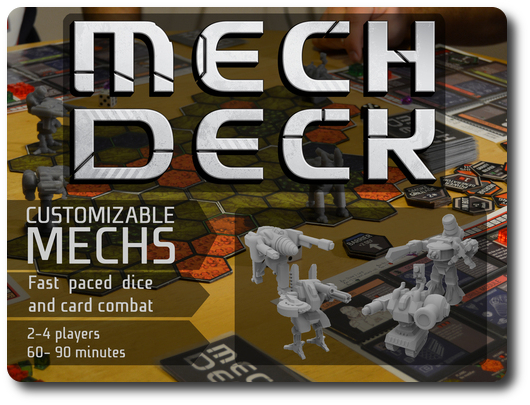
The Basics:
- For ages 8 and up (publisher suggests 13+)
- For 2 to 4 players
- Approximately 60 minutes to complete
Geek Skills:
- Active Listening & Communication
- Counting & Math
- Logical & Critical Decision Making
- Reading
- Emotional Coping Skills
- Strategy & Tactics
- Risk vs. Reward
- Visuospatial Skills
- Hand/Resource Management
Learning Curve:
- Child – Easy
- Adult – Easy
Theme & Narrative:
- Take control of a giant robot and destroy anything that moves
Endorsements:
- Gamer Geek approved!
- Parent Geek approved!
- Child Geek approved!
Overview
Wars have become too expensive and the resources necessary to maintain a standing army are dwindling. Warring countries now resolve their disputes by pitting very large and very dangerous robots against one another. The pilots who control these Mechs are both war heroes and celebrities. You are such a pilot and you have been called to defend your country’s honor.
Mech Deck, designed by Patrick Fahy, will reportedly be comprised of 24 Mech pieces (consisting of 12 “Arms”, 4 “Legs”, 4 “Torsos”, and 4 “Backpacks”), 7 Terrain tiles (consisting of 19 hexagon spaces each), 60 Resource cubes, 8 Battle Fervor/Damage counters, 35 Hex tokens, 52 Deck cards, 31 Mech cards (consisting of 24 Mech Piece Reference cards and 7 “Pilot” cards), 4 standard six-sided dice, and 4 Player mats. As this is a review of a prepublished game, I cannot comment on the component quality.
Introducing Your Mech
Each player will be given a Mech, a giant robot loaded with weapons powerful enough to punch a small crater into the Moon. Each fully constructed Mech consists of 5 pieces: 2 “Arms”, 1 “Torso”, 1 “Backpack”, and 1 “Legs”. Each of these pieces fits together allowing the players to customize their Mech with a wide variety of tactical, defensive, and offensive equipment.
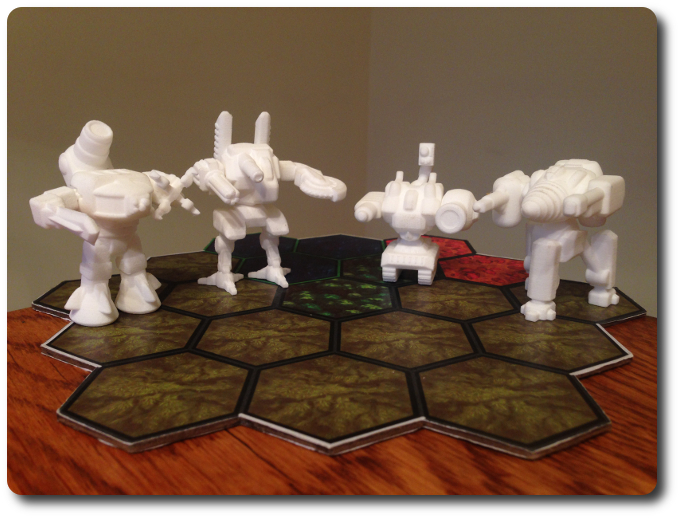
Each piece on the Mech has a matching Mech Piece Reference card that describes its use and keeps track of its current state. When a Mech takes damage, various parts of its body will get damaged, too. Eventually, they will become useless, but a Mech has been designed to take a lot of hits and keep on kicking. Even walking about without arms, a Mech can still pack a punch.
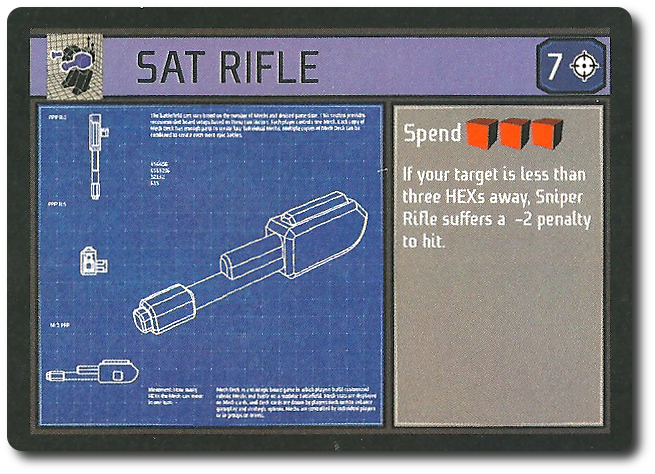
Each Mech must have a Pilot, and like the Mech’s themselves, Pilots bring an additional level of customization. Each Pilot has a special ability or bonus that can be used in the heat of the skirmish to turn the tide. Pilots are, in my respects, the “brains” of the Mech. Unlike human brains, a Mech’s brain is securely seated in the “Torso”. Lose the Mech’s “Torso” and you lose the game.
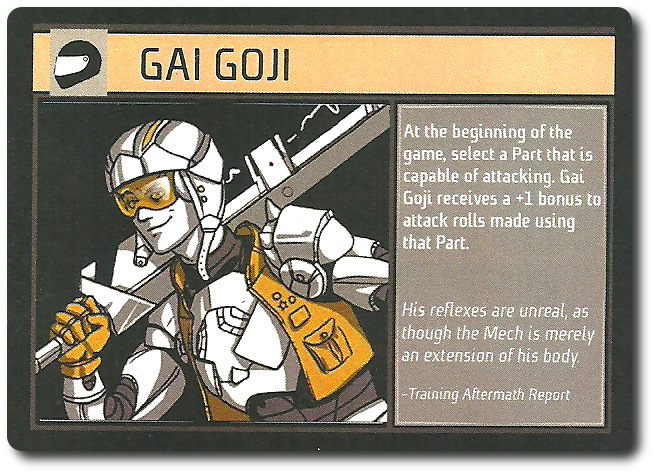
A player keeps track of their Mech’s current state on the Player mat. Everything a player needs to know is listed, tracked, and summarized here. Think of the Player’s mat as the Mech’s control console. A quick glance of the Player’s mat informs the player what is working and what isn’t.
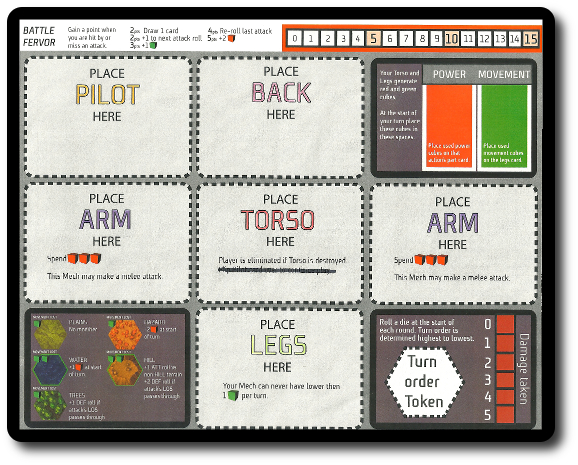
The Deck cards give the player special Actions or Reactions. Think of these as special maneuvers the Pilot uses during the skirmish. All “Action” Deck cards are played during the player’s turn, providing special attacks and make use of Hex tokens that change the battlefield. A player can use some, none, or all their “Action” Deck cards during their turn. “Reaction” Deck cards are played out of turn and in response to an opponent’s attack or when specific conditions on the battlefield are met. Unlike “Action” Deck cards, “Reaction” Deck cards can only be played one at a time in response to a specific condition, which is oftentimes an attack roll.
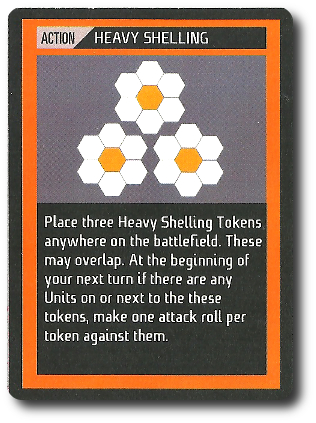
Roll Your Own or Prebuilt Mechs
Mech Deck comes fully stocked with all the Mech pieces players will need to build their own Mech. If the players prefer, they can assemble their Mechs based on prebuilt specifications, allowing them to jump right into battle. If 2 or more copies of the game are combined, players can build a wide variety of different Mechs.
The prebuilt models are listed in the game rules, providing a list of each Mech piece to grab and use to assemble the Mech, including which Pilot to use. Each Mech is fairly well balanced, with an even distribution of Power, Movement, and equipment. Each of the prebuilt Mechs plays very differently. Some are specifically built for up-close combat, while others are clearly meant to engage their opponent at a distance. The prebuilt Mechs provide the players a wide variety of playing styles and choices.
If players want to create their own or customize the prebuilt Mechs, they engage in several rounds of drafting before the game is played. Drafting is only recommended if the players are familiar with the game, as it’s possible to build a Mech that performs poorly. Drafting is done by separating the Mech Piece Reference cards into different piles and having each player either select the top Mech Piece Reference card or “cycle” a pile of cards, which places the top-most card on the bottom. When a player selects a Mech Piece Reference card, they place it on their Player mat. Once every player has selected their Mech pieces and Pilot, they grab the corresponding Mech pieces, build their Mech, and get ready for battle.
Game Set Up
To set up the game, first have each player grab a Player mat and place it in front of them. Then build the Mechs, either using the prebuilt specifications or take turns drafting Mech pieces and Pilots. Any Mech Piece Reference cards and Pilot cards not used are returned to the game box. Built Mechs should remain next to the Player mat at this time.
Second, have each player count their Mech’s “Power” and “Movement” Resource cubes. These are provided by various Mech pieces, as listed on the Mech Piece Reference card. Place the Resource cubes on the reserve space. Each player should also be given 1 Battle Fervor and 1 Damage token, placing these on the starting spaced of the corresponding tracks found on the Player mat.
Third, shuffle the Terrain tiles and then place 1 on the table for every player in the game. For example, if there are 3 players, use 3 Terrain tiles. Terrain tiles should be placed so they are grouped without empty spaces between them. The rule book provides illustrations on various ways to construct the terrain.
Fourth, shuffle the Deck cards and deal 4 to each player, face-down. This is the player’s starting hand. Players should look at their cards and keep them hidden until played. Place the rest of the Deck cards face-down by the Terrain tiles. This is the Deck draw pile for the duration of the game. Leave room next to the draw pile for a discard pile.
Fifth, have each player roll 1 six-sided die to determine initiative. The player with the highest roll is the first player for Mech placement. Turn order sequence is clockwise. Starting with the first player, each player takes their Mech and places it along the edges of the Terrain tiles. After each player has placed their Mech, turn order is reversed. The last player for Mech placement is now the first player for the first round. Give each player their corresponding Turn Order token, which are placed on the Player mat.
Sixth, pool the Resource cubes, Hex tokens, and dice into small piles to one side of the Terrain tiles.
That’s it for game set up. Put your Mech in gear and start blowing up the competition!
Heavy Metal
Mech Deck is played in turns and rounds. A round is over when the last player has completed their turn. A player’s turn is summarized here. Before each round begins, players determine turn order by rolling for initiative. This means the first player of the last round might not be the first player in the next round.
Step 1: Resolve Delay Attacks
The first thing a player does on their turn is resolve any delayed attacks. These were attacks that were played against the player during the previous round. These are resolved like any other attack.
Step 2: Reclaim Resources
During the player’s last turn, Resource cubes were used to power various actions. They are now reclaimed and placed back in the Resource reserve area found the Player mat. If the player is standing on certain terrain types or bonuses, they will need to adjust their Resource cubes accordingly.
Step 3: Kick Butt
This step is all about piloting the Mech into tactical positions and firing weapons. There’s a lot a player can do during this step and much of what is and is not possible is based completely on what Deck cards they have in their hand and the current state of their Mech. The different actions are listed here, but they can be taken in any order and as many times as the player likes if they have the cards and the resources to spend.
Movement
Movement around the Terrain tiles is paid for by using the “Movement” Resource cubes. Each hex space on the Terrain tile represents a specific type of terrain. The base movement cost for all Mechs is 1 “Movement” Resource cube per 1 adjacent hex space moved into. However, the terrain type moved into will modify the base movement. A Mech’s ability to move comes from their “Legs” Mech piece. If the Mech loses their legs, they can still move, but not very fast and some terrain can no longer be entered. Hex spaces that contain an opponent’s Mech cannot be occupied by the player’s Mech.
- Plains: even ground and flat, providing no defense and no obstacles. Mechs move through “Plains” hex spaces without additional modifiers.
- Trees: the dense forest makes it hard to target Mechs hidden in the forrest or fire through it. Mechs move through “Trees” hex spaces without additional modifiers.
- Hill: taking the high ground gives a Mech an attack bonus when targeting other Mechs on lower ground, as well as providing cover if hiding behind them. “Hill” hex spaces cost 2 “Movement” Resource cubes to move into.
- Water: deep and cool, Mechs that start their turn in the water will receive a bonus Power. “Water” hex spaces cost 2 “Movement” Resource cubes to move into.
- Hazard: the battlefield is riddled with craters, pits, and radioactive stockpiles. Mechs that start their turn in the hazardous areas have their available Power reduced by -2. Mechs move through “Hazard” hex spaces without additional modifiers.
Activate Attacks and Abilities
Before, after, or between movement, players can activate any weapons and equipment on their Mech by spending “Power” Resource cubes. Each weapon or piece of equipment can be activated as many times as the player likes as long as they have the resources to do so. When activating any part of the Mech, the player looks to the Mech Piece Resource card to determine what it does and how much Power it takes. The player then moves that many “Power” Resource cubes to the Mech Piece Resource card, indicating that it is now powered up and being used. The ability or effect is then resolved.
As the game progresses, the various parts of the Mech will become damaged. At the start of the game, all Mech Piece Resource cards have their blue side face-up, indicating that it’s in perfect working order. As the Mech takes more and more damage, the Mech Piece Resource cards are flipped over to show the red side. The abilities and effects it once provided might be altered. When the damaged Mech Piece Resource card is destroyed, it’s removed. Mechs are tough, however, and can still keep fighting. Armless Mechs can still attack (although not well) and legless Mechs can still crawl on the ground. The only time a Mech is stopped dead in its tracks is when its torso (and pilot) is destroyed.
Activate Pilot
The Mech’s Pilot might have a special ability that can be used. Each Pilot card will describe what the Pilot provides. Sometimes it’s a bonus and sometimes it’s a special action. Like the Mech Piece Resource cards, each Pilot is unique.
Use “Action” Deck Cards
If the player wants, they can play as many “Action” Deck cards as they like. These cards represent everything from bonus shots to orbital support that drops bombs on nearby enemies. To play a card, the player places the “Action” Deck card in front of them, announces to the table what it does, and then resolve it. “Action” Deck cards describe how they can be used and when. If the conditions are not correct, the “Action” Deck card cannot be played, but nor is the player ever forced to play an “Action” Deck card if they do not want to.
A player only has 4 cards available to them during their turn and only the “Action” Deck cards can be played when the player is taking actions. The “Reaction” Deck cards cannot be played when it’s the player’s turn, but they can be played when the player’s opponent’s are taking their turn. At anytime during the player’s turn, they may discard any number of cards they like from their hand to the discard pile without using them.
Step 4: End Turn
When the player has completed their turn, they announce they are done and draw back up to 4 cards in total.
The next player in turn order sequence now goes. When everyone has completed their turn, the round is over.
Big Guns
At the center of Mech Deck is the combat. All movement and equipment is geared to assist the player in destroying their foes with a wide variety of equipment. Combat itself is very straightforward and brutal, since the battlefield is not that big and has little in the way of cover. Fortune favors the bold in this game, where rushing at an enemy is often a better tactic than retreating.
Ranged combat uses Line of Site (LOS, for short). To determine LOS, an imaginary line is drawn from the center of the attacking Mech’s hex space to the center of the targeted Mech’s hex space. Every hex space of terrain and other Mechs are within that LOS. Depending on what lies between the attacker and the target, additional modifiers will be applied providing bonuses and penalties.
The Mech Piece Resource card will indicate the effective range of the weapon or the piece of equipment’s effect. If the target is within that number of hex spaces, they can be targeted. The attacking player announces their attack, the target, and then the LOS is determined. The attacking player then commits to the attack by moving the appropriate number of “Power” Resource cubes.
The defending player may now use any “Reaction” Deck cards they like, forcing the attacking player to spend more Power or adding more modifiers.
The dice are now rolled. The attacker and the defender roll 2 six-sided dice each, making certain to include any modifiers. If the attacker’s total rolled value is equal to or higher than the defender’s, the attack succeeded. Unless otherwise stated, the defending player now takes 1 Damage, which is tracked on their Player mat. If the weapon or piece of equipment has any secondary effects, it takes place after the dice are rolled. For example, some attacks have a delay that will be resolved during the next round.
The only time a player does not need to roll an attack when attacking on the battlefield is when they are targeting a “Unit” Hex token. The player must still use Power to charge and fire the weapons, but it automatically hits and destroys it.
Battle Fervor
Not all battles are successful and players cannot dodge weapon fire indefinitely. When a player fails to hit a target or to successfully defend against an attack, they gain Battle Fervor. The amount of Battle Fervor the player has available to them is tracked on their Player mat. During the player’s turn, they can spend their Battle Fervor points to obtain additional Power, Movement, attacks, and Deck cards. Very useful, but the only way to obtain Battle Fervor is to fail in battle.

Combat Collisions
Mechs can run into Mechs and even push Mechs. Ramming into another Mech or a unit is considered an attack, but there is no Power spent. Instead, the player attacked by running into the target, using their “Movement” Resource cubes. Running into a “Hill” Hex space, be it on or off the battlefield, forces all the defending players to roll their defense, but the attacking Mech only rolls once. In this way, a player could push 2 or more Mechs and units, crushing them together.
Damage and Destruction
Damage is collected and recorded during the round using the Damage track. At the end of the round, all players determine how much total damage they have taken and then grab that many Damage counters. Each player now assign the damage to the individual Mech pieces of their choice. The Pilot cannot take damage. If a blue side Mech Piece Resource card takes 1 point of damage, it’s flipped to its red side. If a red side Mech Piece Resource card takes 1 point of damage, it is removed, as is the physical piece the card represents. When your Mech takes battle damage, it’s clearly visible to all. A player is still in the game as long as their “Torso” Mech Piece Resource card is on their Player mat.
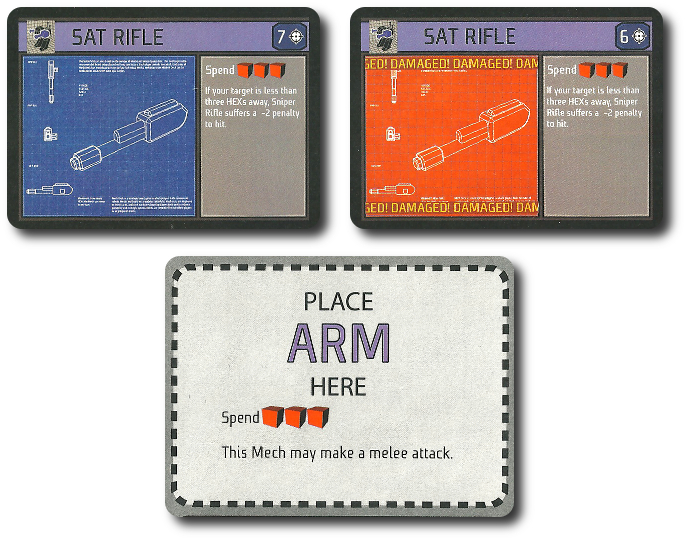
Boss Mech
The battle rages on until only one Mech remains standing. The Pilot of the only surviving Mech has proven their skill and now stands victorious over the burning remains of his fallen foes.
House Rules
Mr. David Hughes asked how our groups handled the downtime between games for those players who were eliminated early. Simply put, not well. We resolved this by removing 1 Terrain tile from play when a player was eliminated. Any Terrain tiles free of Mechs were removed first. If all the Terrain tiles were occupied, we moved the Mechs to another tile and then removed the unoccupied tile. As the game progressed, the available terrain decreased whenever a player was eliminated. This kept battles intense and all the players, be they playing or not, engaged.
To learn more about Mech Deck, visit the game publisher’s website or visit the Kickstarter campaign.
Final Word
It was difficult to determine what the Child Geeks enjoyed more, the customization of the Mechs or blowing them up. In both cases, the Child Geeks were highly enthused and engaged. According to one Child Geek, “What I really like is designing new Mechs and then testing them against other players.” Another Child Geek said, “This reminds me of a much easier version of BattleTech. It’s a lot of fun!” The only Child Geeks who weren’t having a good time were those who were the target of the other players. You can team up against an opponent with another player. Nothing in the rules says you can’t or shouldn’t. After all, only 1 player can win, so feel free to make temporary alliances. This didn’t sit well with some of the Child Geeks. One very upset Child Geek said, “I hate this game! Everyone keeps blowing me up!” Harsh feelings aside, all the Child Geeks voted to approve Mech Deck. They also voted to not allow teams, no matter how temporary the alliance.
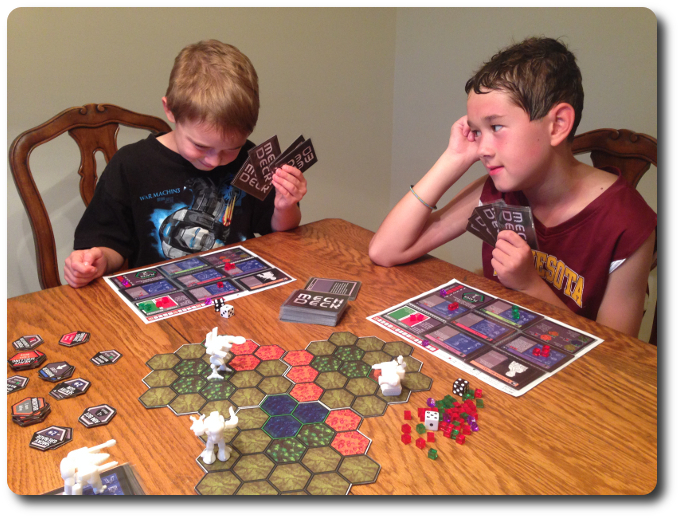
My two little geeks discuss the possibility of taking me out. THEY SHALL FAIL!!!
The Parent Geeks, when they weren’t telling Child Geeks to “fight fair” by shooting everyone equally, had a lot of fun, too. One Parent Geek said, “I’ve been a fan of miniature skirmish games for years and this one really appeals to me. I like how easily you can customize and start playing.” Another Parent Geek said, “This game reminds me a lot of RoboRally, but with a lot more aggressive action. I’m really enjoying it, but don’t like it when all my kids gang up on me.” The Parent Geeks suffered the same thing as their Child Geeks. Specifically, being the one and only target worth shooting at. The Child Geeks relished seeing their parents dismantle their Mechs piece by piece, and so did the Parent Geeks. When all the battles were over, the Parent Geeks approved Mech Deck.
There were a few BattleTech players among the Gamer Geeks and they were very critical of Mech Deck, but not to a point where they compared the two games as equals. According to one Gamer Geek, “What this game lacks in true strategic and tactical game play it makes up for in intense skirmishes and aggressive game play.” Another Gamer Geek said, “I’m not sure I like the cards and the random abilities they provide, but I love how the Mechs work and the removable pieces.” And finally another Gamer Geek said, “What saved this game from being rejected by me is the customization. I want to spend more time just building the perfect Mech.” All the Gamer Geeks agreed the Mech Deck was a lot of fun, highly customizable, and would be a big hit at their gaming table.
Mech Deck can best be thought of as a mix of VOLT, RoboRally, and BattleTech. It shares many of the same movement, combat, and tactical game play, but Mech Deck
stands on its own. It combines what I think is the best of these three games to create a gaming experience that feels unique, if not altogether new. While many players were head-over-heals in love with the customization aspect of the game, I was more taken by the game’s ease of accessibility. I taught my two oldest Child Geeks how to play BattleTech which was no easy feat. They quickly took to Mech Deck without issue, but it left me wondering if they would have had an easier time playing BattleTech if they played Mech Deck first? I think so based on how Child Geeks not familiar with BattleTech quickly learned and enjoyed Mech Deck.
My only concern is the Mech construction. We were given a prototype version which didn’t stay together very easily. This caused a lot of frustration, but was forgivable since the game is not yet published. When it is, those Mech pieces better lock in place and stay in place until they need to be removed. And when they are removed, they best wiggle out without too much effort or break. Anytime you have a game with pieces that connect together, you will inevitably run the risk of something bending or snapping. Time will tell, but I very much hope the final models are designed in such a way as to make the process of damaging a Mech in battle not lead to actually damaging the game piece.
Mech Deck is pure giant-robot fun. Combat is swift and brutal. Players will be spending most of their time figuring how to tactically put a rocket up an opponent’s nose rather than strategically considering their survival. This is not a game you ask a soft-hearted individual to play. It can feel punishing at times and immensely unfair when 2 or more opponents decide you are the target. But that’s the game and part of the fun is attempting to outlast each other. When the dust settles and the winner emerges, what you’ll talk about most is how badly things went and how epic the fight was.
This is a paid for review of the game’s final prototype. Although our time and focus was financially compensated, our words are our own. We’d need at least 10 million dollars before we started saying what other people wanted. Such is the statuesque and legendary integrity of Father Geek which cannot be bought except by those who own their own private islands and small countries.



